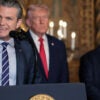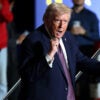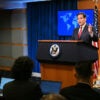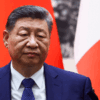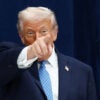Critics of President Donald Trump’s response to the coronavirus crisis characterize it as “knee-jerk,” “spur of the moment,” and “grasping at any straw within reach.”
In fact, many of the recent executive actions we have seen reflect a new approach to health policy that has been underway almost since the day Trump was sworn into office.
They include the ability to be diagnosed and treated without ever leaving your own home; the ability to talk to doctors 24/7 by means of phone, email, and Skype; and the ability of the chronically ill to have access to free diagnoses and treatments without losing their access to health savings accounts.
In each of these areas, the Trump administration has already pushed the limits of executive authority. The emergency created by the COVID-19 coronavirus has given the administration the freedom to do much more.
The Ideal Response
Have you ever wondered how a free market for health care would handle the COVID-19 crisis?
Most patients would have a health kit in their home, with a temperature gauge, blood-pressure cuffs, and an oxygen sensor. Patients would have those because doctors, hospitals, and health plans would encourage them.
Patients with older models would call in the readings to their doctors. Newer models would send the doctor an automatic, electronic alert if there were reason to be concerned.
The initial doctor-patient contact would probably be by phone. If warranted, a virtual face-to-face examination by Skype or similar device would take place.
If the services of a specialist were required, that connection would be made—again, remotely and electronically. Also, a variety of smartphone apps would help doctors more easily diagnose and connect with their patients remotely.
If the patient were suffering from a cold or a mild case of the flu (which likely would be the case more than 90% of the time), the doctor would order a prescription, which would be filled and delivered by a local pharmacy.
In the face of coronavirus indications, a doctor or nurse would arrive at the home (within an hour), take a swab sample, and perform a COVID-19 test—with results in, say, 10 minutes.
In the serious cases, patients would go to the emergency room. But that would not be a scene of coronavirus roulette, as it is today. Hospitals would know in advance which patients had the virus.
A special team would be there to greet these patients. They would be escorted to isolated rooms with appropriate equipment and safeguards to protect other patients and hospital personnel.
The demand for special masks (with better protection than the masks you see surgeons wearing on TV), ventilators, and other equipment would rise dramatically. But it would be a targeted demand, informed by real data. You wouldn’t see hoarding and oversubscribing by providers who scramble to get more than they need “just in case.”
The demand would be met by suppliers who would work nights and weekends to step up production because, well, they expect to get paid extra, just like in any other market.
So, why aren’t these things being done now? They are being done, but not as often as they should. The reason: government.
Getting Diagnosed in Your Own Home
If you go to a doctor’s office or a hospital emergency room, you risk infecting other patients or being infected yourself. So, why not stay home?
Telemedicine is being used extensively in China to diagnose the coronavirus right now. Vice President Mike Pence and major health insurance companies say it is “the first line of defense” against the virus. And more than 40 million Americans currently can get doctor consultations by phone, email, or Skype. Yet federal and state laws have been standing in the way.
In the private sector, the ability to deliver medical care remotely, say, by means of phone, email, Skype, and Zoom is growing by leaps and bounds. It promises to lower costs, increase quality, and lower the time and travel cost of patient care. Until recently, however, Medicare rarely paid for any of this.
Congress was the culprit.
Federal law (the Social Security Act) allows Medicare to pay for telemedicine only under strictly limited circumstances. For the most part, the law allows doctors to examine, consult with, and treat patients remotely only in rural areas, and even there, the patients can’t be treated in their own homes.
The Centers for Medicare and Medicare Services has been acting aggressively to change that. Under one rule change, Medicare Advantage plans and Accountable Care Organizations can bill Medicare if they consult with patients remotely to determine if they need an in-office visit. Patients can be anywhere, including in their own homes.
How did Centers for Medicare and Medicaid Services chief Seema Verma get away with these changes? By reclassifying these activities as “virtual medicine” instead of “telemedicine.” The communications are labeled “virtual check-ins.”
Still, these were baby steps. The coronavirus created an opportunity for bolder action under the rubric of emergency authority.
After the coronavirus struck, Verma used the president’s executive authority to give Medicare Advantage plans broad discretion with respect to remote diagnosis and treatment.
Congress also chipped in with legislation that allows Medicare to pay for telemedicine in connection with the coronavirus, but it imposed an onerous restriction; namely, the doctor must have had a relationship with the patient in the previous three years.
That requirement is a disastrous barrier to remote medical care. It would make virtually every telemedicine company in the country and every hospital online-screening service ineligible. Fortunately, the administration is using its emergency powers to override the restriction.
Medicare doctors can now use telemedicine devices to diagnose and treat anyone even suspected of having the virus, regardless of where they live and regardless of any previous doctor-patient relationship.
The Trump administration has also suspended federal licensing regulations so that doctors who are licensed in any one state can deliver services to patients who reside in some other state.
For the reform to be fully operational, governors need to use their emergency powers to suspend state-level restrictions as well. Texas and Massachusetts have already done so. Let’s hope more states follow suit.
Having 24/7 Access to Your Doctor
Coronavirus symptoms don’t occur just during working hours, but the ability to talk to a doctor by phone at any time—including nights and weekends—used to be a privilege available only to the very rich. Fortunately, what is now commonly called “direct primary care” is becoming widely available.
A model first developed by Atlas MD in Wichita, Kansas, has made round-the-clock care available to almost everyone. A mother, for example, can have full access to all primary care 24/7 for only $50 a month. A child costs an additional $10.
With the spread of the coronavirus, demand for this kind of service is soaring, and the administration has signaled the federal government will not stand in the way.
The administration has made two regulatory changes to facilitate the opportunity.
First, enrollees can now get direct primary care services under Medicare. Second, employees can now use their health savings accounts to pay the monthly fee for direct primary care.
Neither option was allowed under the Obama administration.
Getting Tested in Your Own Home
The first known persons with the COVID-19 virus were discovered in the United States and in South Korea at about the same time. Since then, South Korea has engaged in a massive testing campaign (including drive-thru testing) to determine who has the virus and who doesn’t.
As of mid-March, that country had tested more than 5,000 people for every 1 million residents. By contrast, the number tested in our country was 125 for every 1 million residents. In fact, the U.S. testing rate was about the lowest in the developed world.
U.S. officials claim that the tests used in other countries are not as accurate as those approved by our government. Even so, the proof is in the pudding. As Alec Stapp writes in The Dispatch:
South Korea has effectively contained the coronavirus without shutting down its economy or quarantining tens of millions of people. … Hong Kong, Singapore, and Taiwan have also managed to contain the virus via a combination of travel restrictions, social distancing, and heightened hygiene.
Until early February of this year, all testing for COVID-19 had to be done at the Centers for Disease Control and Prevention in Atlanta. Once the CDC recognized it was ill-prepared to handle a pandemic, it sent out testing kits to about 100 public-health centers around the country. Unfortunately, about half of the kits were defective.
Trump on numerous occasions has made clear his desire to wipe away regulatory obstacles. In that vein, Alex Azar, the secretary of health and human services, declared a public health emergency on Feb. 4. Since then, any lab that wants to conduct its own tests for the novel coronavirus can get authority under something called an emergency use authorization from the Food and Drug Administration.
Although this was supposed to usher in deregulation, the emergency use authorization process brought with it a new set of bureaucratic obstacles. The entire process, described in great detail by Robert Baird in The New Yorker, reads like an episode of the “Keystone Cops.”
The Trump administration has responded to this regulatory morass by successively relaxing the rules on emergency use authorization approval. In response, Roche, Eli Lilly, and other drug companies have stepped forward.
Things are enormously better than they were when Trump took office, but the process is still too slow.
For example, Biomerica has developed a test that involves little more than a finger prick. It can be performed by trained professionals almost anywhere—schools, offices, homes, etc. The test—which sells for $10 per patient—has been approved in Europe and is being used in other countries. But as of this writing, it’s still not approved for use in the U.S.
Here’s a reasonable rule that should guide the government in a public health crisis: If a test is approved in Europe, it should be available to patients in the United States.
Another private-sector innovation should help in planning for coming health care needs. Kinsa Health has developed smart thermometers that are internet-connected.
It has given away or sold a million of them to households in which a combined total of 2 million people reside. The company, which can track the flu across the country in real time, says it can do the same for COVID-19 at a time when U.S. health officials have been flying blind.
Getting Treated in Your Own Home
In principle, most patients who have a cold, the flu, and even the coronavirus can be monitored and treated in their own homes.
A smartphone is a powerful computer connected to a communications device. Smartphones are already being used by physicians to monitor patients and by patients to send data to their doctors for a variety of conditions.
But due to the bureaucratic nature of American medicine, we have only begun to scratch the surface of the possibilities. There are apps to monitor cardiac health and perform EKGs, devices to perform ultrasound scans and allow endoscope exams of the throat. If needed, a nurse practitioner could visit the home and help with the procedure.
There are other alternatives to hospitalization that could meet the needs of many patients, absent oppressive regulation. Intermediate care centers could isolate and care for patients, for example. Such a center could be in hotels that are now sitting empty.
Patients who need to be monitored or who run the risk of infecting family could convalesce in a setting that costs a few hundred dollars per day rather than thousands or tens of thousands for a hospital stay.
Getting Care Without Excessive Out-of-Pocket Spending
In the Obamacare exchanges, there appears to be a race to the bottom, as insurers try to attract the healthy and avoid the sick. They attract the healthy by keeping their premiums as low as possible. They repel the sick with high deductibles and very narrow provider networks. (Employers face these same perverse incentives, but the response has not been quite as bad.)
Trump has persuaded major insurance company executives to agree verbally to waive deductibles and copayments to encourage potential coronavirus victims to get tested and treated.
The administration has also stretched its regulatory authority by defining coronavirus treatment as an “essential health benefit,” whose coverage is required by law. That’s a salutary development, but going forward, public policy needs to address all the perverse incentives embedded in current law.
A related development concerns health savings account regulations. More than 26 million people have a health savings account, and these accounts contain almost $62 billion in assets.
Employees and their employers can make tax-free deposits to them, and the balances grow tax-free. However, these tax advantages are only possible if the account is combined with a catastrophic health insurance plan that has an across-the-board deductible (currently $1,400 for individuals and $2,800 for families).
Say an employer with a diabetic employee encourages compliance with needed treatment by making certain drugs and monitoring devices available without charge. That makes good medical sense and good economic sense, but it would disqualify the health savings account plan, since patients must spend up to their deductibles before getting services for free.
Last year, the administration relaxed the health savings account rules to allow some chronic care to be provided without violating the high-deductible requirement. A new IRS ruling solves the same problem for coronavirus detection and treatment.
Considering that health savings accounts were created by an act of Congress, those executive actions are very aggressive.
Getting Health Insurance That’s Personal and Portable
The final change concerns the kind of health insurance people have.
In a dynamic economy, people change jobs frequently, and that is generally not a bad thing. But job changes typically mean changing your health insurance, and that often means changing your doctor as well.
For the chronically ill, continuity of care achieved by a continuing relationship with doctors is usually better care.
Under the Obama administration, employers who provided pretax dollars to the employees to purchase individually owned health insurance could be fined as much as $100 per employee per day, or $36,500 a year. That was equal to the highest fine in all of Obamacare, and it brought the practice to a grinding halt.
The Trump administration has abolished the fine and encouraged the practice the Obama White House sought to outlaw. As of January, employers have been allowed to provide pretax dollars to employees who can buy their own health insurance.
Getting Health Care Providers the Equipment They Need
The health care industry is the most regulated industry in our economy. Virtually everything that is used to treat a coronavirus patient is regulated by the federal government—masks, gloves, gowns, respirators, ventilators, you name it.
A normal business can’t produce and sell any of these items without the government’s permission. And getting permission can be a long and laborious process. The federal government even tells hospitals how many beds they can have.
Small wonder, then, that when the COVID-19 crisis hit, there was a shortage of everything—and everyone predicted that the shortage would only get worse as the virus made its way through the population.
Since 2005, there has been a federal stockpile of protective medical gear to guard against a pandemic. But in early 2020, the number of masks on hand equaled about 1% of what some predicted the national need would be.
Another attempt was made to stockpile ventilators under the well-founded belief that they would be in short supply in any future epidemic. That effort was a complete failure, however.
If we had followed the rules, thousands—perhaps millions—of patients would be unable to get the medical care they need. Fortunately, the Trump administration has been willing to bend them.
Deregulation of industry has been a major goal of the administration since Day One. And there is no sector of the economy where it has been more needed than the health care industry, especially when faced with the COVID-19 pandemic.
Private industry is stepping up to meet the need because relaxation of burdensome regulations is allowing it to do so:
- 3M is able to convert industrial-use masks to health care purposes, and after Congress gave it protection against lawsuits, it began producing 35 million N95 masks a month.
- Ventilators made for industrial use can be retrofitted for health purposes. General Motors is partnering with Ventec Life Systems. Ford is partnering with 3M and General Electric. General Motors and Ford are both in talks with Tesla to do the same.
- Before the coronavirus hit, Ventec was producing 150 ventilators a month. Soon, it expects to ramp up to 1,000.
On both the right and the left there have been calls for a command-and-control approach. For example, some in Congress called on the president to invoke the Defense Production Act, a Korean War-era authority, to compel private industry to step up production of masks, ventilators, and other items.
Apparently, the Federal Emergency Management Agency came close to invoking the act to get increased production of masks. New York Gov. Andrew Cuomo has even suggested that the relevant companies be nationalized, if needed.
Trump has wisely resisted this approach in most instances, noting that Venezuela shows the futility of command-and-control economies.
As in the case of medical tests, more could be done. Given the current state of emergency, we should approve any medical device that has already been approved in Europe. And as Hoover Institution economist John Cochrane has suggested, if you want people to work nights and weekends to step up their output, government should be willing to chip in and make it worth their while.
Exercising the Right to Try
Another reform championed by the president is to allow patients to try drugs that have not been approved by the FDA if the patient is terminally ill. He now says the same principle should apply even if the patient is not terminally ill.
Hydroxychloroquine, for example, is an existing drug used to treat rheumatoid arthritis and systemic lupus, and appears to be effective with COVID-19. Chloroquine is an 85-year-old drug that is safe for use to prevent malaria, and it appears to be effective here as well. (It has worked for other SARS viruses.) As the president asks, “What have you got to lose?”
The president has been criticized for mentioning those drugs at White House briefings. What the critics rarely mention is that 1 in 5 of all drugs prescribed in the United States are used “off-label”—that is, prescribed for a use that has never undergone a controlled clinical trial.
The president is encouraging doctors to approach the coronavirus the way they typically approach other health problems. Also, doctors themselves apparently think these drugs are worth a try. They are hoarding the drugs for possible personal use.
Although off-label uses of drugs are quite common, it’s illegal for a drug company to advertise the off-label uses of a drug it manufactures and sells. Drug companies can’t even send out medical journal articles to physicians that report on the success of off-label uses.
If an executive of a company that makes a malaria drug went on TV and made the same statements Trump has made, the executive could wind up in prison.
Things took a radical turn for the better, however, on March 29. That’s when the FDA took the highly unusual step of issuing an emergency use authorization allowing the malaria drugs to be used by doctors to treat the coronavirus.
The Department of Health and Human Services in a statement announced that Sandoz had donated 30 million doses of hydroxychloroquine and that Bayer had donated 1 million doses of chloroquine to a federal stockpile to be distributed to physicians.
More generally, the White House is encouraging the medical community to ignore the red tape and try to find out what works. That’s as it should be.
Making Health Reforms Permanent
One reason the country is doing as well as it is in defending against COVID-19 is that Trump began deregulating the health care market early in his presidency.
Those efforts have laid the groundwork for further deregulation that has freed patients, doctors, and other providers to meet the health care challenge unrestrained by unwise, counterproductive legal restrictions.
A second reason has been the willingness of Congress to enact additional deregulation by law.
However, almost every good reform passed by Congress is limited to the duration of the coronavirus crisis. If the crisis goes away, the freedom of doctors to efficiently meet patient needs also goes away.
Additionally, reforms created by the president’s executive orders could easily be reversed by the next president’s counter-executive orders.
What is needed is to make these reforms permanent, by securing them in law.
Trump is the first president in more than a century who has understood that in health care, government is not the solution; it is the problem.
Let’s not lose sight of that vision.
Portions of this analysis were originally posted at Forbes (here and here).
